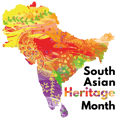South Asian Heritage Month: Memories of Eid
As South Asian Heritage Month 2023 is all about celebrating the stories that make up our diverse and vibrant community, I am happy to share some fond memories of my cultural celebration of Eid over the years.
As many will already know, Muslims celebrate two Eids. The first is Eid-ul-fitr, which is celebrated at the end of Ramadan, a month that is devoted to prayers and fasting by Muslims across the globe. The second is Eid-ul adha, which is celebrated to mark the culmination of the annual pilgrimage to Mecca, a journey which is made by millions each year.
The celebrations in my family for each Eid look very different. Eid-ul-fitr has always been emphasised more and the preparations begin weeks ahead of time. The buying of presents for the family, or ‘eidi’ being a cash token, is the fun part. Then there are the new outfit purchases, deciding who will host the big family meal this year and, of course, discussions around the menu, which actually becomes quite a nice thing to think about whilst fasting. I have two brothers and we usually take turns to host.
The night before Eid (also known as chand raat in Urdu) represents excitement and anticipation for the next day. Each year, the definitive announcement as to whether Eid is the next day is made after sunset by the local mosque. Often different days are celebrated by different mosques, so WhatsApp conversations are rife at this point as to who is celebrating when.
The evening comprises of a family get together to start food preparations and chat. The females decorate their hands with henna (also known as mehndi), with designs often selected days ahead of time in line with their outfit of choice or whatever the latest trend on the socials is.
On Eid day, it’s an early start for all. The males in our family will attend the Eid prayer at a local mosque and wish everyone they meet. Their arrival back will be met by something sweet that is home made, like rice pudding or sweet vermicelli - a customary routine that has been followed for centuries in many households. Any final meal preparations will ensue followed by the family gathering together for the main events, the meal and presents.
If any evening meal is planned at a different house, the afternoon nap will feature as a mandatory step after eating far too much.
As Eid-ul-fitr runs for three days, a similar routine is followed across all of the days, with the second and third day focussing more on wider family members and friends. Food remains a constant theme and any healthy habits of moderate eating during the fasting month quickly dissipate.
In contrast, Eid-ul-adha, is more subdued. It is celebrated for a day and doesn’t usually involve presents or weeks of planning. It is a laid-back day with family coming together to enjoy good chat, play friendly party games, have at least one meal together. To mix things up, we sometimes book a trip together and celebrate on holiday.
There is a religious element to this day. Meat is distributed to family, neighbours and the needy by those who can afford to do so. Good deeds are also encouraged, as is charity to help those in less fortunate situations have a good day.
Both occasions are close to my heart because they represent union, charity and joyous times with our loved ones.
As the world becomes more aware of our cultural richness, the celebration of diversity is a real joy to see. Whether it be in the form of your non-Muslim connections wishing you Eid Mubarak, witnessing the first ever celebratory lights in London this year, or significant leaders of Asian heritage in the form of our First Minister and Prime Minister, there is certainly a lot of inclusivity to celebrate!

Celebrating South Asian Heritage Month
South Asian Heritage Month kicks off today, to commemorate and celebrate South Asian cultures, histories and communities. Amerdeep Kaur, a solicitor at Drummond Miller LLP and member of the Law Society of Scotland's Equality and Diversity Committee, explains what celebrating the month means to her.

South Asian Heritage Month
Find out more about South Asian Heritage Month

